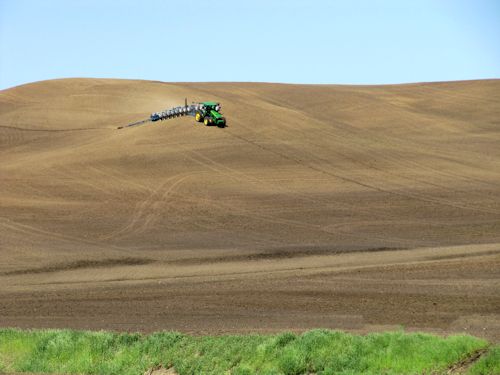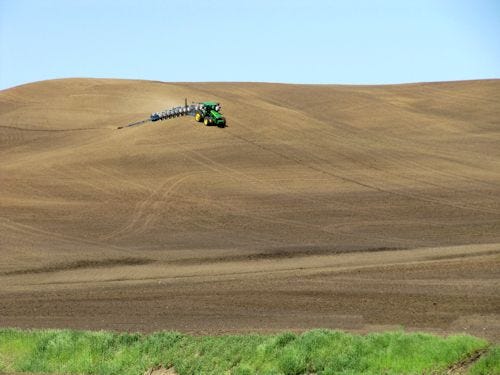
A regular contributor to Wallaces Farmer magazine, Jason Johnson has written an article that will appear in our March issue about how to match machinery size to soil conservation needs when farming Iowa's steep slopes. As machinery gets wider, particularly planters, this is getting to be a big concern in local soil and water conservation district offices in the state. The increasing size of farm machinery is making it more difficult for row crop farmers to maneuver Iowa's hillier ground.

NO CONSERVATION: This farmer in the Loess Hills is planting down the hill, instead of along the contour. There are also no visible conservation practices, such as residue management, terraces or grass waterways to help reduce risk of erosion.
Jason is a public affairs specialist for USDA's Natural Resources Conservation Service in Iowa. When he sent me his article and photo (see accompanying photo) I thought about titling the photo "HERE COME THE REGS" because that's what some people will think when they see the picture; they'll say tougher regulations are needed to control soil erosion and prevent nutrient loss.
If you want crop insurance, you'll have to control erosion
But the new, tougher regs are here. The 2014 Farm Bill signed into law on Feb. 7 ties conservation compliance to crop insurance. To be eligible for coverage, you'll have to control erosion. USDA still needs to write the rules to figure out how to carry this out, but the law is on the books. We've had conservation compliance as a requirement for USDA farm program eligibility since the 1985 Farm Bill but now it applies to crop insurance, too.
The farmer in the photo is farming in the Loess Hills of western Iowa and is planting down the hill, instead of along the contour. There are also no visible conservation practices, such as residue management, terraces or grassed waterways to help reduce the risk of erosion. He'll have to change this if he wants to remain eligible for crop insurance coverage.
Following are some excerpts from Jason's article
Iowa's soil and water conservation advocates are asking farmers to match machinery size with their conservation needs when farming Iowa's steep slopes. Large, wide equipment is often difficult to maneuver around many of Iowa's traditional conservation practices, causing many farmers to reduce or eliminate conservation where it is most needed.
~~~PAGE_BREAK_HERE~~~
Mark Hanna, Extension ag engineer at Iowa State University, says farmers need to consider what is best long-term for the land they farm. "In sloping areas that benefit from contouring, it is often not practical to use wide equipment used in flatter areas," he says. "Tighter turns nearer the top of slopes can minimize the capacity effects of equipment that is too wide."
For decades, Iowa farmers have been planting crops along the contour, instead of up and down slopes, and implementing other erosion control measures on their farms to help reduce the risk of soil erosion and prevent crops from washing away. But, as farmers work more acres and upgrade to larger equipment to improve efficiencies, conservation methods and structures, like grassed waterways and terraces, are all too often perceived as production obstacles rather than necessary tools to protect the environment and long-term sustainability.
Erosion causes soil to degrade over time, which can substantially decrease the soil's productivity. This stems from reduced topsoil depth, organic matter and nutrient availability. Unproductive soil can also lead to an increase in inputs, costing the farmer money long-term and increasing the risk of nutrient runoff or leaching.
Use smaller planters in areas where it makes sense
LuAnn Rolling, district conservationist with USDA's Natural Resources Conservation Service in Allamakee County, says although 24- to 48-row planters may be useful in central Iowa or other flat areas across Iowa they don't make as much sense in areas like northeast Iowa.
Rolling believes that a 12- or 16-row planter on steeper slopes is the maximum with many slopes even too steep for these to help maintain conservation practices. "It takes about 60 feet to turn big equipment," she says. "Grassed headlands (field borders) are now either gone or there is just a narrow strip of grass with 24 or 48 rows up and down the hill beside them."
~~~PAGE_BREAK_HERE~~~
For more information about the benefits of conservation and how to make today's machinery and work with conservation management practices, visit your local NRCS office located at the USDA Service Center in your county.
Why are conservation practices important?
Since the Dust Bowl in the 1930s, farmers have been implementing conservation on their land to reduce soil erosion. Since then, many soil conservation practices have shown to improve soil health, which stabilizes the soil and aid in production. Conservation practices also improve water and air quality, promote biological diversity, and help attract wildlife.
Farmers using large equipment often struggle to navigate these conservation practices on hilly ground:
Contouring is preparing the soil, planting and cultivating crops around a hill rather than up and down the hill. Crop rows run around the slope, nearly level. The rows form small dams to slow runoff.
Terraces reduce erosion by intercepting runoff on slopes, transforming a hillside into a series of shorter slopes.
Grassed waterways reduce gully erosion using grass channels to convey water to a stable outlet at a non-erosive velocity.
Field borders are bands of vegetation around perimeter of a field that provide a turning area for farm equipment. They eliminate the planting of end rows up and down hills.
To learn more about standards for these and other conservation practices, visit the Iowa NRCS website and click on "Iowa Conservation Practice Standards."
About the Author(s)
You May Also Like




